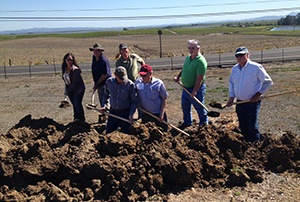
While the West Coast drought has been catastrophic for grapegrowers in some areas of California, it has had little impact on vineyards in other parts of the state. Comparing data about groundwater tables in various California grapegrowing regions highlights how different conditions can be.
First, the bad: Groundwater tables have plummeted in parts of the San Joaquin Valley and in Paso Robles on the Central Coast.
On the San Joaquin Valley’s west side, the water table plunged 400 feet in the early and mid-20th century due to pumping, but now it has dipped even lower. “Because of increased pumping, groundwater levels are reaching record lows—up to 100 feet lower than previous records,” said Mark Cowin, director of the California Department of Water Resources. This is a result of farmers pumping groundwater to replace missing surface water deliveries due to the drought.
In Paso Robles, the water table has dropped more than 70 feet in parts of the east side, where most wine grapes are grown.
North Coast not impacted much Yet in the North Coast counties of Sonoma, Napa, Mendocino, Lake and Marin, geologic conditions allow some areas to recharge each year—even in a multiple-year drought—and maintain a fairly constant level of groundwater.
According to an interim report about groundwater levels that Napa County staff provided to the Board of Supervisors in September, area groundwater levels remained stable or increased between spring 2014 and spring 2015 in spite of California’s drought.
Wells with long-term records in the Napa Valley floor showed water levels in spring 2015 were above those recorded at the same time during the 1976-77 drought, which was the worst drought on record both in Napa Valley and throughout California.
Throughout March 2015, Napa County staff recorded groundwater levels from a total of 94 wells along the Napa Valley floor, in the Milliken-Sarco-Tulucay Creeks (MST) area east of Napa, Carneros and other areas.
Groundwater levels remained stable or increased at wells monitored in Napa, St. Helena, Calistoga, Yountville between spring 2014 and spring 2015.
Even two areas that have seen wells dropping in the past reported water levels that were stable or better: Groundwater levels increased or remained stable in 18 of 21 wells in the MST between spring 2014 and spring 2015. The water tables in this area have mostly stabilized since 2008, though some wells continue to drop.
Year-to-year declines were observed in a few wells in southeast St. Helena, southwest Yountville and northeast Napa.
Carneros is also low in groundwater, but groundwater levels were stable in nine of 10 wells with at least two years of data between spring 2014 and spring 2015.
Pipelines are being laid to both MST and Carneros to deliver recycled water from the major water treatment plant in Napa.
James F. Verhey of Big Ranch Vineyards, who served on the Napa County Groundwater Resource Advisory Committee, noted that Napa Valley is in pretty good shape with ample water availability, though there are documented groundwater concerns in the MST and Carneros regions.
He noted that once the ground is saturated, which takes 10 to 15 inches of rain, depending on soil type and location, additional rain flows into the Napa River and into the San Francisco Bay. The situation is different for cities and Central Valley farmers dependent on the state water project, where every inch of rain/snow in the Sierra Nevada range and southernmost Cascade Range is critical.
He added that when rain occurs is as important as how much rain occurs—for agriculture, 1 inch in March may be more important than 3 inches in December.
Another grower who served on the committee was Peter McCrea of Stony Hill Vineyards. He said, “We didn’t have a rain drought in Napa Valley. California had a snow drought in the Sierra.” He added that his vineyard in the Mayacamas Mountains got 30 inches of rain—not the usual 40, but hardly a drought.
Other coastal counties Several other counties on or near the coast appear similar to Napa.
Glenn McGourty, the UC extension vineyard advisor in Mendocino and Lake counties, noted that groundwater recharges pretty well in Mendocino County, but the county has limited groundwater. “We aren’t in near the trouble as the San Joaquin Valley and Paso Robles, where there are serious drops in water table levels. But in the long term, local groundwater storage is terrible because we simply don’t have the geological structure for good water storage (deep fissures and alluvium).”
Likewise, in nearby Lake County, Debra Sommerfield, president, Lake County Winegrape Commission, said, “My understanding is that while the water table was low a couple of years ago, the levels came back rather quickly after the storms last winter, at least for the Big Valley area.”
Scott De Leon, director of the Lake County Department of Public Works, told Wines & Vines, “In general, the groundwater basins in Lake County have shown good recovery over the past few years of drought. Though annual spring elevation numbers have trended slightly lower than historical averages, the declines are not significant.”
